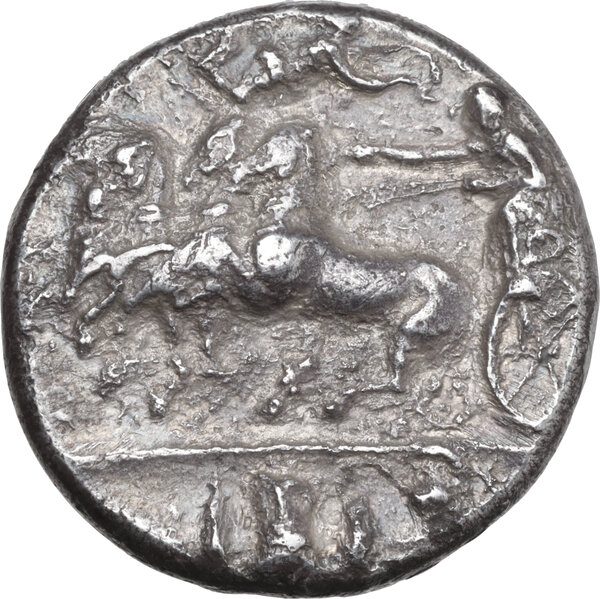









拍品号 140:
Sicily. Syracuse. Dionysos I (405-367 BC). AR Dekadrachm. Unsigned dies in the style of Euainetos, c. 405-400 BC. Obv. Charioteer driving galloping quadriga left, holding kentron in right hand, reins in left; Nike flying right above, crowning charioteer; in exergue: a military harness, shield, greaves, cuirass and Attic helmet all connected by a horizontal spear. Rev. Wreathed head of Arethousa left, wearing triple pendant earring and necklace, surrounded by four swimming dolphins; shell behind; [ΣYPAKOΣIΩN]. HGC 2 1299; SNG ANS 372; Dewing 903-906; Jameson 829; Boston MFA 426. 41.84 g. 34 mm. RRR. Toned. Rusty die on obverse. Nice classical style portrait. VF. The decadrachm of Syracuse is one of the most impressive and celebrated silver denominations of classical times, and remains one of the most fascinating masterpieces in numismatic history. With its large module, this coin offered the engravers of Syracuse ample room to express their mastery. After a brief experimental issue in the 460s BC, the decadrachm was reintroduced under the tyrant Dionysius I in 405 BC, marking an ambitious attempt to elevate Syracuse to the capital of the Greek world. Two of the most distinguished local numismatic artists, Kimon and Euainetos, were responsible for creating the coinage for this series, each infusing their own distinctive style into the well-known emblems of Syracuse. The obverse of the coin depicts a quadriga, a four-horse chariot, triumphing in the race, while the reverse shows the head of the beautiful Arethusa, nymph of the spring of Ortygia, surrounded by dolphins. Both engravers were so proud of their work that they signed their coinage, similar to the practice of modern artists. Some of the decadrachm coinage features symbols, such as a shell, in place of the signature, suggesting the involvement of apprentices who emulated the work of the masters.
起拍价 € 10000
当前出价 € 14000
出价数: 6
无可供出售
当前出价 € 14000
出价数: 6
无可供出售





